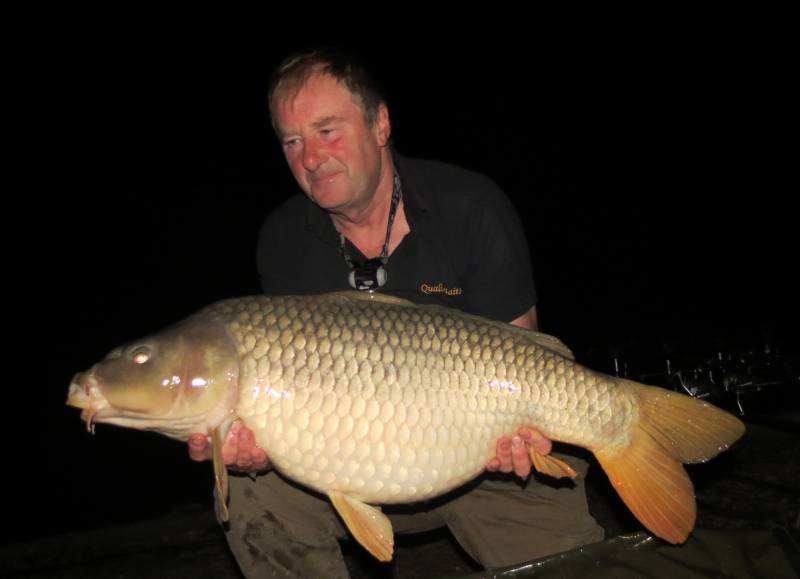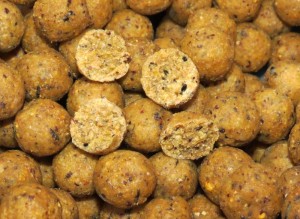It was mid October when Jim Kelly and I visited Brocard Small lake. Small does not describe this lake correctly. It is around 29 acres, this being the lesser acreage of two lakes set in a huge forested area, with the larger being around 39 cares. There are approximately 350 carp in Brocard Small as with around 500 in Brocard Large.
Swims 1 to 4 are generously spaced on the small lake, with swims 5 to 12 on the large lake.
From swim 3 looking down the lake towards swim 4 on the damOur job was to test Brocard Small. On our arrival I plumbed and leaded various sections of this lake. I settled to fish swim 3. Jim jumped into swim 2 and by mid afternoon we were ready to cast a line.
Swim 3 is a large double swim. There is ample room to assemble all the fishing paraphernalia by the waters edge with a larger area at the back of the swim to erect 2 bivvies and umbrellas for your kitchen etc. What I am going to talk about is how I chose my selected baited area, what problems I encountered and how I overcome them to make my week into a successful one.
As I was fishing the swim by myself, I erected my bivvy by the waters edge so that I was closer to my rods.
The far tree-lined margins of swim 3The far tree lined margins are approximately 108 meters away, so after plumbing and leading the swim I settled on a slightly silted area of the lake 10 meters off the far margins, making it a comfortable 98 meter cast, this also giving me ample room to hook any carp away from any snags. The depth of the water averaged around 1.5 meters Having marked up all my fishing rods, along with the spomb rod, I set about building up a baited area.
The weather had deteriorated over the past few days before our arrival and the forecast was not looking too good either, rain, rain and more rain was forecast with temperatures around 12C in the day and 7C at night. The water temperature had also been drastically effected, and was now feeling quite cold. This drop in temperature could be either a feeding trigger for the carp or a total killer.
I initially introduced by spomb, around a kilo of mixed sized boilies to an area around the size of a table tennis table, with one rod in the middle of the baited area and the other set just off the area. Before darkness set in, I withdrew all three rods to examine for any poison chat or crayfish damage to the baits. It was evident that I had a crayfish problem, boilie stops removed and baits either totally removed or damaged.
Half pint mug and one of the CraysUnfortunately our tiger nuts had been left at home, and all that I was armed with was boilies in the form of Quality Baits HG All Seasons and Patshull Park mix with my selected flavours.
31lb 3oz still coming to the HG All SeasonsMeshed boilies or plastic baits was to be my answer, but the crayfish were still hammering the meshed baits and almost emptying the mesh of bait over a 10 hour period.
The two resident swans that took a liking to my baitI could do only one thing, and that was to try and feed off the crayfish. This hopefully would leave at least some freebies for the carp to have a look at. I maintained my small baited area, fishing plastic boiles only over the bait. The other rods were fished well off the baited area with heavily meshed 18 mil HG All Seasons boilies, as these baits contain no fish or oils. Before darkness I spombed out a further 3 kilo of boilies onto my baited area and settled down for the first night. My theory was that I would try and get as many crayfish in the baited area leaving my meshed hook baits almost untouched.
Meshed HG All Season boilie with a short hook rig on the Ultimate pop-up rigThis seemed to work, as on the first night I had 2 runs on the outer rods.
I thought that I could short cut the process of spombing out my baits, so come midmorning on the Sunday I cast out my marker rod to correctly indicate my baited area, and off I set to the far bank with a bucket of boilies and my chest waders. I waded out into the lake from the far margin and baited by hand my selected baited area. As I was baiting up in around 1.5 meters of water I took no notice of the two adult swans that came around from the side of a bush and sat there watching me. They even came up to the marker rod, but being complacent and confident in my actions I never realised the consequences of my laziness.
Back to my swim to cast out my baits. I could not believe what I was witnessing. All I could see was the tails of both swans waving to me as the they set about helping themselves to my free offerings! With the Cray’s and the swan’s I was well blessed. Baiting by spomb only would have to be done during the hours of darkness.
Three days into the session it became evident that the carp were only feeding during the hours of darkness and up to an hour into daylight on the morning.

29lb 14oz
My answer to the swan problem was to regulate their feeding and to draw them away from my baited area. As soon as they approached my baited area I whistled the swans, shook a bucket of boiles and called them over to the near bank, then fed them. It worked, but cost me a lot of wasted bait and bread, but they left me alone.
Now as my carp tally increased I noticed that most of my runs were single bleeps or very slow runs and it was essential that I watched the rod tip following an occurrence before striking the rod. The lake water was getting colder and I worked out that the carp had switched into winter mode.
Another 30lb 15oz mirror caught during one of the many heavy showersI corrected my fishing tactics by fishing very short hair rigged bait along with short hook links of no longer that 3 inches. This worked a treat, and every run following was a screamer. The carp had previously been picking up my hooked baits and were able to move around sufficiently to eject or show very little indication on the longer hook links.
Through working out what was needed to over come the angling problems that I was encountering, I managed to land 18 carp during a very hard week’s fishing.
Conclusion

One of the best baits Jim and I have developed, HG All Seasons from Quality Baits
It is very important that when selecting a baiting area, that it is not beyond your casting range. If the wind changes or becomes too strong you do need to be able to cast your hook baits accurately back to the baited area on every cast. Do not stretch yourself too much as it could end up in disaster for the week’s fishing. . If you are using a bait boat, what do you do if it breaks down, go home? No! Only use the boat at a distance that you can cast too.
Also ensure that if you are spombing, take spare spombs, as with catapults, take spare elastic, and I always take 2 throwing sticks as well. Sometimes a spread of bait could be the answer.
Always be prepared for nuisance species, such as Poison Chat or Crayfish, and if allowed, take a kilo of prepared Tiger nuts.
I know that most anglers use bait boats abroad, but sometimes the casting approach will out fish small dumps of bait presented by a boat. So always be prepared for the unexpected and be prepared to change your tactics to suit the situation.
Paul Cooper
[email protected]

Comments